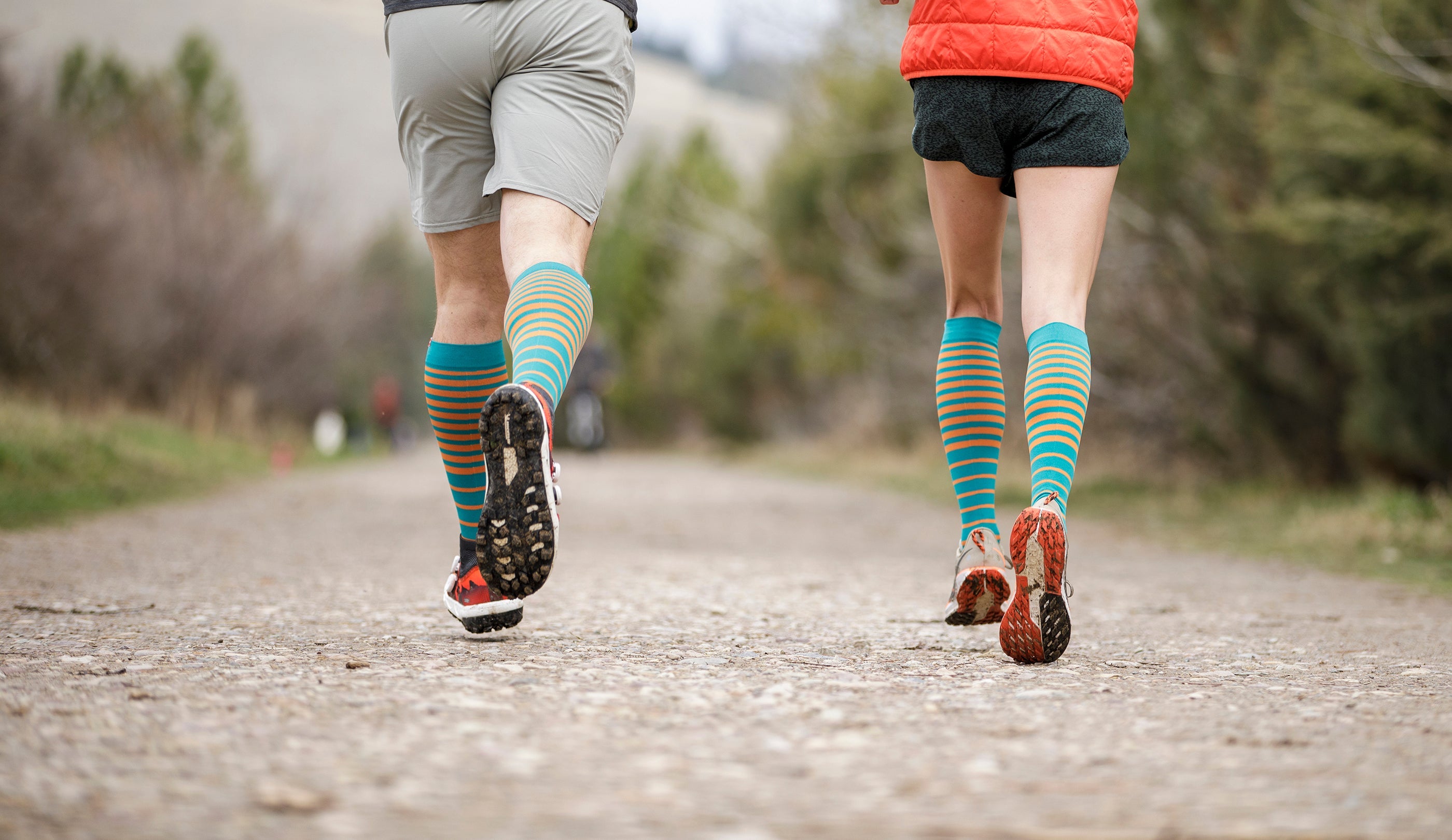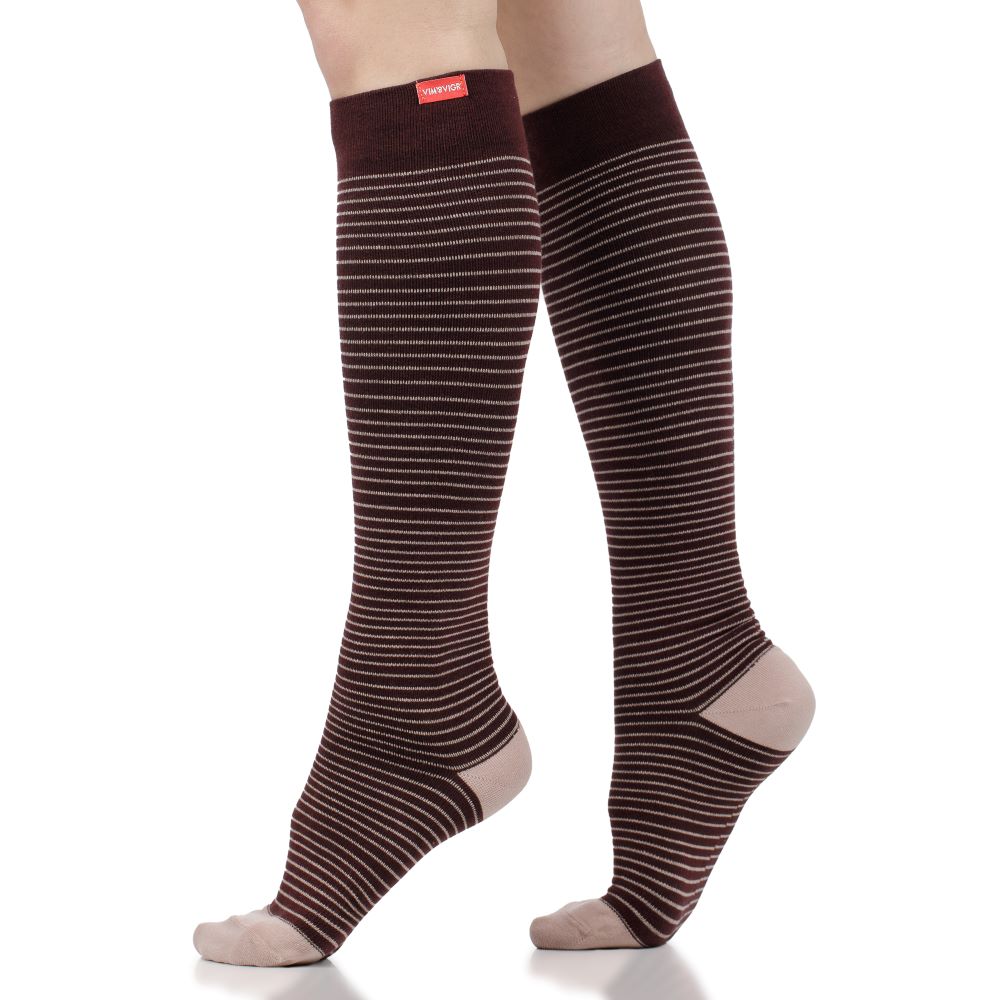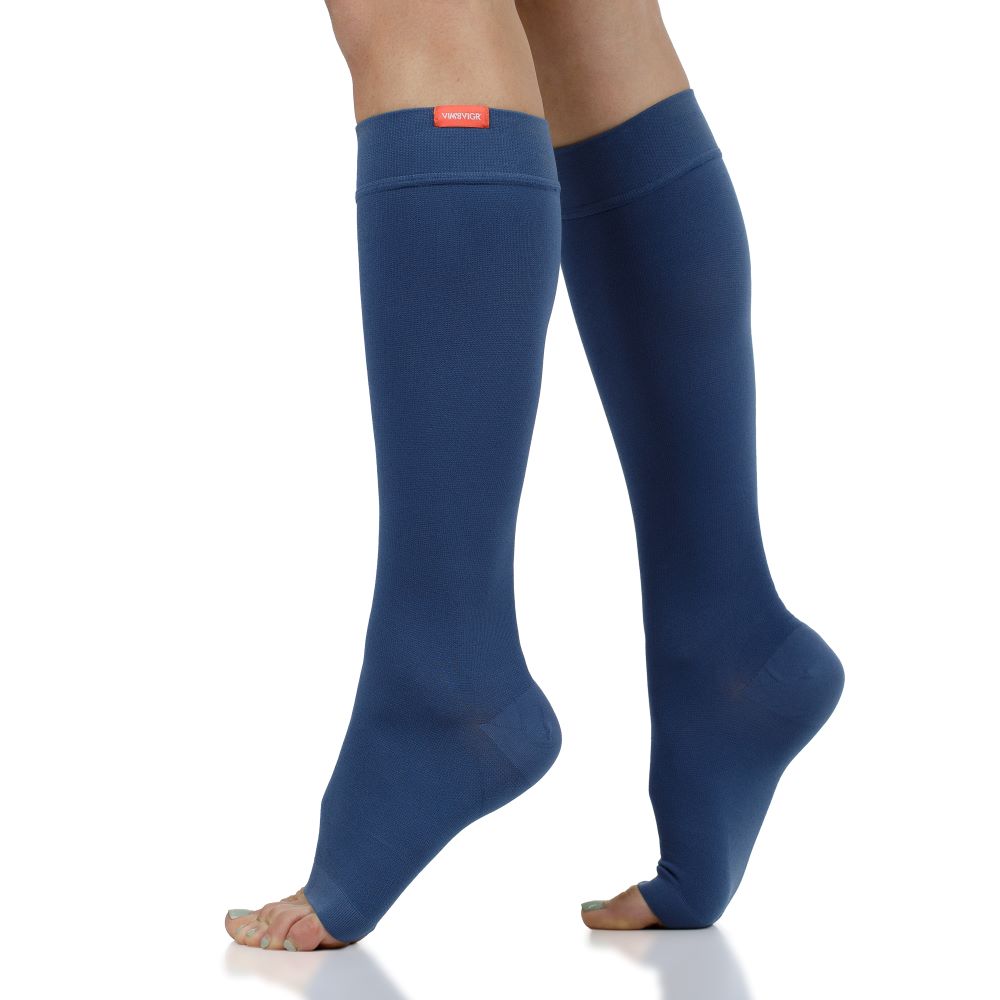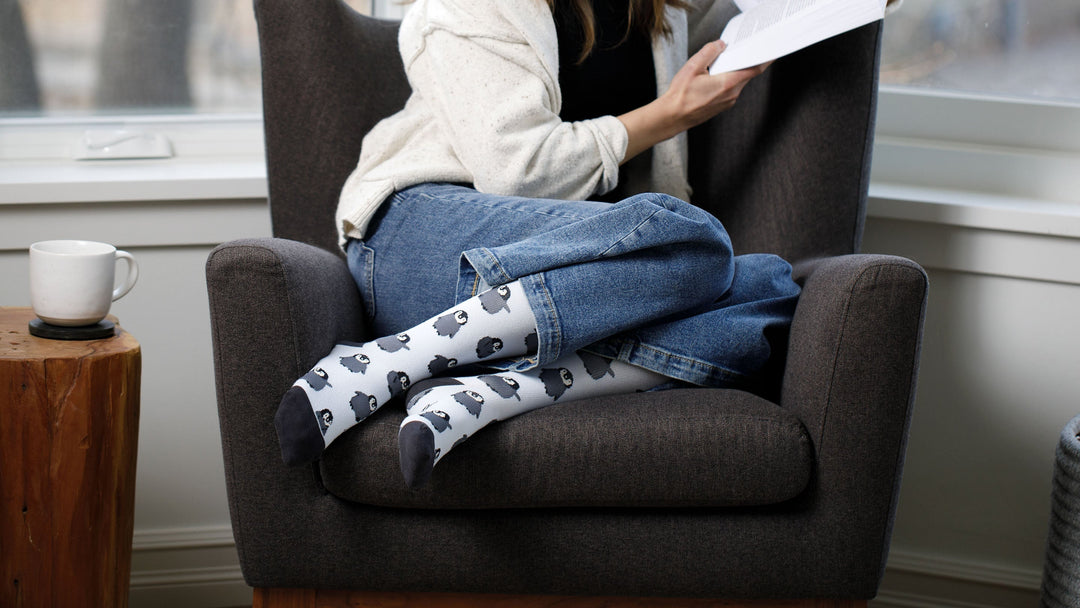What is mmHg and What Compression Level is Right for You?
Written By Alecsa Stewart
Scientifically Reviewed by Daniel Chantigian
Compression socks work effectively by gently compressing your leg to move blood more efficiently through your leg (we like to think of it as a therapeutic hug). Compression pressures are measured in mmHg (millimeters of mercury). Our compression socks use graduated compression technology, this means that our socks are tightest in the ankle (highest mmHg) and gradually less tight towards the top of the sock. Graduated compression guides blood up and through the leg, which has been found to help with varicose veins, reduce swelling, prevent and treat edema, and prevent blood clots or deep vein thrombosis (DVT).
Compression socks can be worn running, at work, hiking, traveling, and are often prescribed to people with chronic illness by doctors. You may be wondering; how can compression socks be used for all of these hobbies as well as medically? This is because compression socks can come in different pressure levels, fabrics, and sizing.
Now you may be wondering, “which compression level is right for me?” In this article, we will walk you through how to choose the best compression level for you and what activities you should use compression socks or stockings for.
To kick things off, we asked Caitlin Reid, PT, a physiotherapist with a special interest in holistic and environmental well-being, to help us break down why people should consider using therapeutic compression, how to find the right level of compression, and what levels mean. Reid stated:
“If you are sick of daily swelling and aching in your lower legs, it is time to find a compression sock or stocking to help. The first step is deciding which level of compression you need. Whether you are looking to use compression socks to help you recover after a hard workout, help a swollen injury heal or help you manage a chronic illness, there is a level of compression to suit you.”
What Is mmHg?
The notation mmHg refers to millimeters of mercury. It is a measurement of pressure, originating from the pressure a 1-millimeter-high column of mercury could generate. Millimeters of mercury (mmHg) is the most common pressure notation used in hospitals, clinics, and medical researchers. Within medicine though, mmHg is commonly used; both intracranial pressure (pressure inside the skull) and blood pressure are measured in mmHg. Despite this, it is not a common measurement outside the medical field. For science lovers out there, 1 mmHg is equivalent to 1/706th of an atmosphere of pressure.
Compression Socks and mmHg
Compression socks and stockings are not all the same. They are made to have a diverse range of compression pressures for various activities or medical conditions. Compression comes in a range divided into different classes under two main classifications: Afnor (Association Française de Normalisation) and RAL (European Union classifications). Each classification utilizes ranges, as compression garments are often crafted in a graduated fashion. This means the compression is highest at the ankle (which is the higher number of the ranges below), and slowly decreases as it moves up your leg (terminating at the lower number in each range).
Below is an outline of how both systems break down the level of compression:
Afnor Compression Classification:
-
Afnor Class 1: 10-15 mmHg (Very light compression)
-
Afnor Class 2: 15-20 mmHg (Light compression)
-
Afnor Class 3: 20-36 mmHg (Moderate compression)
-
Afnor Class 4: 36+ mmHg (Strong compression)
RAL Compression Classification:
-
RAL Class 1: 18-21 mmHg (Light compression)
-
RAL Class 2: 23-32 mmHg (Moderate compression)
-
RAL Class 3: 34-46 mmHg (Strong compression)
-
RAL Class 4: 49- mmHg (Very strong compression)
What Is the Best Compression Level for Sport Recovery?
To help muscles recover after sports, compressions socks and stocks are usually Afnor Class 2: 15-20 mmHg. Clinical studies have found that using compression at this level can boost the tissue repair of micro tears that occur during normal exercise, which can lead to faster recovery. Micro tears of muscles can cause swelling, which leads to post-activity soreness (often called DOMS or delayed onset of muscle soreness).
Compression socks, leggings and sleeves work as a pump to reduce swelling and alleviate feelings of heavy legs. They enhance the transport of water and lymph fluid out of the legs, as well as boost the circulation of metabolites. A 2022 research report has also shown that compression may reduce the levels of inflammatory molecules in localized areas.
Not only do compression stockings and socks help make your muscles feel less achy after exercise, but research shows they may also decrease muscle fatigue and may even minimize perceived exertion.

What Is the Best Compression Level for People Who Sit All Day at Work?
Sitting all day at work can cause swelling and aching in your legs and feet. This swelling is known as occupational edema. If you are required to sit or stand all day, the best way to minimize occupational edema is by wearing compression socks or stockings, and this study confirms that compression socks can be effective for treating occupational edema. For these garments to be effective, though, you need to have the right level of compression.
To find the best compression level for people who work in different positions, one study looked at 58 people in three different groups with:
-
Sitting jobs
-
Standing jobs
-
Mixed (both standing and sitting)
According to the study, of these people, no one had any illnesses that would cause increased swelling in their limbs. Each person had volumetric measurements of swelling for both limbs taken at the end of three consecutive days:
-
Day 1: No compression garment worn
-
Day 2: 15-20mmHg compression garment worn
-
Day 3: 20-30mmHg compression garment worn
After day two, there was significantly less swelling in all three groups. Plus, the reduction in edema was more notable in individuals working in a prolonged seated position.
In other words, the researchers concluded:
-
Regardless of whether you stand or sit at work, you will experience less swelling in your legs and feet if you wear compression garments.
-
Particularly if you have a sedentary job, wearing compression garments of 15-20 mmHg dramatically helps minimize leg swelling and subsequent discomfort versus not wearing them and 20-30 mmHg garments may provide even more benefits.

Who Are Medical Compression Stockings For?
Many chronic health problems and other medical conditions can increase the amount of swelling you experience in your legs. These include:
-
Venous leg ulcers
-
Diabetes
-
Sleep apnea
-
Blood Clots
-
Heart Disease
-
High Blood Pressure (aka Hypertension)
-
Liver disease
-
Chronic venous insufficiency (from smoking, obesity, recent surgery, complications from using contraceptives, and more)
For these populations, there are medical-grade compression socks and stockings available that may help treat symptoms of these chronic health conditions. Compression is considered medical grade if it is 20 mmHg and above. Always be sure to consult your care team if you have a medical condition and are considering using compression socks to alleviate symptoms.
Are Medical Compression Stockings for Everyday Life?
You can absolutely use medical compression socks or stockings every day. Medical-grade compression is not only for those who suffer from a chronic illness or increased DVT risk. It is for people looking to have their legs feel energized and light, people recovering from injury or surgery, or to improve exercise recovery or performance. They are also known to be effective for preventing circulation problems and blood clots on planes. If wearing compression of 15–20 mmHg doesn’t seem to be minimizing the swelling in your legs enough, higher-grade (or medical-grade) compression may be more effective.
It is important to note, though, significant swelling in the legs is not normal for most people in everyday life. Let your doctor know about the swelling so they can see if there is a more serious cause.
Where Can You Buy Fashionable Medical Compression Stockings?
Thanks to innovative compression brands like VIM & VIGR, medical compression stockings don’t have to ruin your outfit, whether you’re flying overseas or sitting all day at work. Offering everything from brightly striped compression socks for under your outfit at work to more subtle black compression stockings that are perfect for pairing with a dress and boots, great brands make caring for your leg health easier and more stylish than ever. Medical compression stockings are not just the white stockings you see in hospitals anymore; they can be a fashionable part of your regular, wearable wardrobe.
Whether you’re looking to boost your tissue healing after a long run or you need a stylish way to minimize the swelling and discomfort in your legs at work, there is a level of compression sock or stocking perfect for you. Find a stylish compression brand and choose the mmHg that suits your needs.
Shop New Compression Sock Styles
Choosing the Right Compression Sock Material
On top of offering a variety of compression garments, we offer our compression socks in a variety of fabrics so you can figure out what is most comfortable for you day to day! Our compression socks come in cotton, merino wool, nylon, and moisture wick nylon.
Our 4 functional fabrics are as follows:
COTTON
Our 200-needle count cotton blend is soft and made with natural fibers. The flexibility in our cotton fabric allows for our most spunky designs, and many customers report that their feet stay cool while wearing them - even in the summer months!

MERINO WOOL
We use the highest quality (sustainably sourced) Merino Wool for our socks. This 200-needle count fabric is known for its moisture-wicking and temperature regulating ways. Customers love this fabric for everyday wear, and for outdoor activities!

Shop Merino Wool Compression Socks
NYLON
For the longest time, we have knit our nylon socks on a 400-needle count machine, this left a high-quality sleek feel to the sock, and a 4 way stretch that was unmatched. However, it limited our ability to make fun designs, and left a seam in the toe. In 2022, we released another version of our nylon sock called Choice Nylon. This uses the same fabric as our Classic Nylon socks, but leaves a softer feel and allows for more designs. All while eliminating the toe seam as well. We will be keeping our Classic and Choice Nylon around for a while, so let us know which one you like better!

MOISTURE WICK NYLON
This high-quality nylon is also great for temperature regulation. It uses a different fabric than our Classic Nylon and Choice Nylon socks and is knit on a 400-needle count machine. These socks give the feeling of stockings and are loved by many of our customers!
Finding your perfect compression sock will take some trial and error. Luckily, we have a 100% satisfaction guarantee and allow free returns if the compression sock you get isn’t perfect. When choosing a compression sock, we recommend looking at your lifestyle and health needs.

Shop Moisture-Wick Nylon Compression Socks
Caitlin Reid is a freelance journalist, copywriter and PR coordinator with over 10 years of experience with clients around the world. She is also a physiotherapist with a special interest in holistic and environmental well-being, blending the realms of evidence-based medicine with inspiring holistic health.
References
Brown, F., Gissane, C., Howatson, G., van Someren, K., Pedlar, C., & Hill, J. (2017). Compression Garments and Recovery from Exercise: A Meta-Analysis. Sports medicine (Auckland, N.Z.), 47(11), 2245–2267. Read it here.
Chan, V., Duffield, R., & Watsford, M. (2016). The effects of compression garments on performance of prolonged manual-labour exercise and recovery. Applied physiology, nutrition, and metabolism = Physiologie appliquee, nutrition et metabolisme, 41(2), 125–132. Read it here.
Lim, C. S., & Davies, A. H. (2014). Graduated compression stockings. CMAJ : Canadian Medical Association journal = journal de l'Association medicale canadienne, 186(10), E391–E398. Read it here.
Mosti, G., Picerni, P., & Partsch, H. (2012). Compression stockings with moderate pressure are able to reduce chronic leg oedema. Phlebology, 27(6), 289–296. Read it here.
O'Riordan, S. F., Bishop, D. J., Halson, S. L., & Broatch, J. R. (2022). Compression-induced improvements in post-exercise recovery are associated with enhanced blood flow, and are not due to the placebo effect. Scientific reports, 12(1), 16762. Read it here.
Partsch, H., Winiger, J., & Lun, B. (2004). Compression stockings reduce occupational leg swelling. Dermatologic surgery : official publication for American Society for Dermatologic Surgery [et al.], 30(5), 737–743. Read it here.
Quilici Belczak, C. E., Pereira de Godoy, J. M., Seidel, A. C., Belczak, S., Neves Ramos, R., & Caffaro, R. A. (2018). Comparison of 15-20 mmHg versus 20-30 mmHg Compression Stockings in Reducing Occupational Oedema in Standing and Seated Healthy Individuals. International journal of vascular medicine, 2018, 2053985. Read it here.
Sachdeva, A., Dalton, M., & Lees, T. (2018). Graduated compression stockings for prevention of deep vein thrombosis. The Cochrane database of systematic reviews, 11(11), CD001484. Read it here.


















Hi Greici and Kristi – for long hours of flight, we would highly recommend our 15-20 mmHg compression socks. They are ideal for all-day, every day wear, and offers moderate support to reduce ankle and leg swelling, ease tired and achy legs, and aid in muscle recovery. They are commonly used for travel, mild to moderate edema, pregnancy, spider and varicose veins.
What level MMHG is recommended for a 14 hour international flight?
Thank you!
Hi there, I am 10 weeks pregnant and looking for a compression stockings for my flight 10h travel.
I am not sure which one should I get.
Thank you
Hello. I am traveling on a plane for at least 12-14 hrs. What mmhg would you recommend?
I purchased 20-30mmhg already, and they are easy to put on and feel like they provide light compression.
Do you have a light compression ankle sleeve. I have arthritic hands and have trouble getting the higher compression sleeves on and off.
Leave a comment